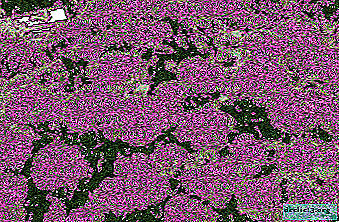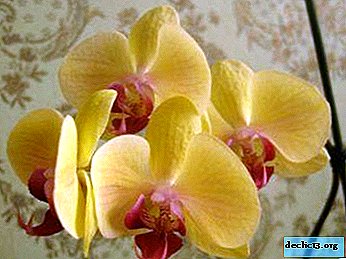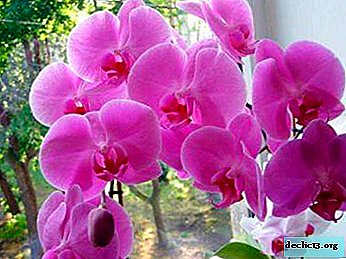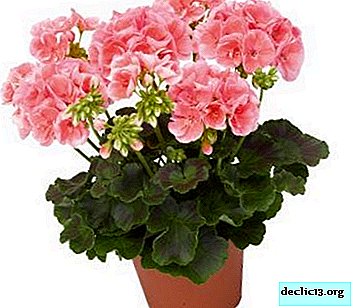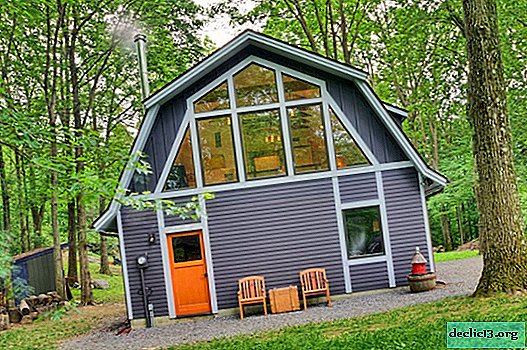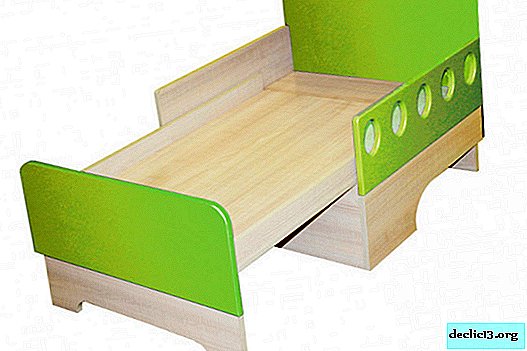Features of the selection and preparation of soil and fertilizers for growing pomegranate in room conditions and in the open ground
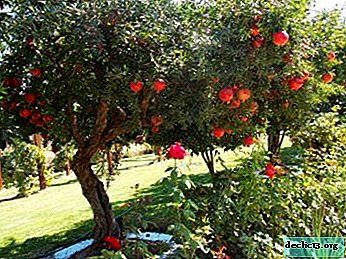
Pomegranate is an ancient culture, the fruits of which bring unconditional benefits to health. Pomegranate ripening is possible in a city apartment and in the open ground.
For normal life, pomegranate needs to provide air access to the roots, a balanced diet and a supply of nutrients in the soil. How to do it?
Consider in the text below the features of the selection and preparation of soil and fertilizers for growing pomegranate indoor and outdoor.
The importance of proper soil
The pomegranate is not picky about the soil - it grows well on clay, crushed and sandy soils, on neutral or carbonate. On moisture-intensive fertile, well-drained loamy soils gives the best results.Pomegranate growing on properly prepared soil forms many long-pied flowers of the first flowering period and, accordingly, more fruits.
Pomegranate growing on improperly prepared soil slows or stops growth and flowering, ceases to resist diseases and pests.
What land is needed?
The soil mixture for pomegranate culture at home is prepared from four components: turf and leaf soil, sand and humus in a ratio of 1: 1: 1: 0.5.
Step-by-step instructions for preparing soil for a houseplant
 Preparation of earthenware mixture for indoor pomegranate:
Preparation of earthenware mixture for indoor pomegranate:
- River sand must be washed with running water to get rid of excess clay.
- The components are mixed in the right proportion, sieved or crushed - the lumps should be the size of a pea.
- The resulting soil is disinfected in a water bath for an hour.
The bottom of the container is laid out with a layer of drainage from expanded clay, clay shards or coarse sand, the soil mixture is covered.
Preparation of soil for planting in open ground
Step-by-step instructions for preparing an earthen mixture for growing pomegranate tree:
- Turf land - in meadows and fields, cut layers of earth with turf, stacked in stacks in pairs with grass to each other, watered. After 2 years receive a nutrient soil, well permeable to water and air.
- Sheet earth - woody leaves, except for oak, willow and chestnut, are raked in heaps in the fall. Turn over regularly and watered with water.To eliminate excess acidity of the substrate, slaked lime is added to the leaves - 500 g / m³. For 2 years, it turns out and fertile leafy land.
- Compost prepared from soil and any organic materials - manure, fresh grass, straw, hay, kitchen waste. A layer of organic matter with a height of 25 cm is sprinkled with 4 cm of earth. A pile is periodically watered. Compost is ready after the organic matter has completely decomposed.
- Sand use river, washed in vivo.
The components are mixed and filled into a trench or landing pit.
The composition and cost of the purchased mixture
Various soil mixtures for growing pomegranate are commercially available., which includes all the necessary nutrients.
Finished soils for pomegranate, composition and cost.
| Title | Structure | Volume (L) | Cost in rubles | |
| In Moscow | In St. Petersburg | |||
| Hera "Good Earth" |
| 10 | 91 | 95 |
| Bio-soil "Air" |
| 40 | 359 | 365 |
| Peter Peat "Garden" | Peat soil with a hydraulic agent. | 10 | 94 | 98 |
| Biofere "Russian Fields" | Used for making soil mixtures | 5 | 95 | 91 |
| Hera "3 D" universal for home and garden |
| 50 | 300 | 303 |
Ready mixes are used for planting and transplanting, as well as for adding or changing the topsoil.
The value of fertilizer for shrubs
 Pomegranate responds positively to the application of mineral fertilizers. Fertilizing is carried out when the plant has fully taken root. Symptoms of malnutrition:
Pomegranate responds positively to the application of mineral fertilizers. Fertilizing is carried out when the plant has fully taken root. Symptoms of malnutrition:
- nitrogen - growth slows down, leaf color changes;
- phosphorus - stops growth, root development and flowering;
- potassium - brown spots and burns appear on the leaves;
- calcium - points of root and apex growth are affected;
- magnesium- the process of respiration of the plant is disturbed, the leaves turn pale;
- iron - leaves turn yellow, pomegranate lags behind in growth;
- manganese - leaves twist, development slows down;
- boron - weak flowering, the growth point dies;
- zinc - small leaves with pale spots.
How to apply top dressing?
- In the phase of growth, flowering and early fruiting - in the summer.
- Immediately after removing the winter shelter from the plants, they are fed with nitrogen-potassium fertilizers.
- Indoor pomegranate is fed during the growth period every 2 weeks with complex fertilizers.
When to fertilize?
Mineral starvation is judged by the appearance of the plant. - in this case, fertilizing is carried out with the necessary elements. Good results are given by a combination of root and non-root top dressing.
Types of mixtures
Mineral and organic fertilizers are used, as well as micronutrient fertilizers containing elements necessary for the plant in small quantities.
Ready
Ready-made fertilizers, which include the entire nutrition complex, can be purchased in specialized stores.
| Title | Type of | Act | Volume | Cost in rubles | |
| In Moscow | In St. Petersburg | ||||
| Soft power for fruit trees | Horse manure bioconcentrate | Stimulates growth and root formation | 1l | 132 | 139 |
| Chicken droppings | Dry granules | Increases soil fertility | 5 kg | 286 | 280 |
| Potassium humate | Microfertilizer | Increases resistance to diseases and pests | 10 g | 22 | 25 |
| Iron chelate | Microfertilizer | With iron deficiency | 10 g | 22 | 24 |
| Health Turbo | Powder | Stimulates root growth, improves winter hardiness | 150 g | 74 | 76 |
| Urea | Powder | Enhances growth and development | 1 kg | 92 | 91 |
| Dune | Biofertilizer is added to the soil during planting and as root dressing | Enriches the soil | 1 liter | 93 | 90 |
Ready-made fertilizers are used strictly according to the instructions.
How to feed them?
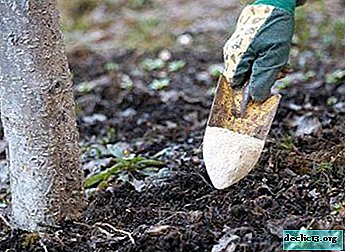 Root dressing is carried out as follows: 8-10 ml diluted in 1 liter of water, bring under the root after watering.
Root dressing is carried out as follows: 8-10 ml diluted in 1 liter of water, bring under the root after watering.- Foliar top dressing is carried out as follows: 4-5 ml diluted in 1 liter of water, spray the plant in the evening.
- Before the root dressing procedure, it is necessary to water the plant.
- With foliar application, the plant well absorbs nutrition from solutions of weaker concentration.
- A sick tree is not fed.
What to look for when choosing?
Buy fertilizers intended for fruit crops. Pay attention to the composition: complex fertilizers are taken for top dressing, and micronutrient fertilizers are used to make up for the missing trace element.
Natural
Organic fertilizers are humus, rotted bird droppings or manure of farm animals.For top dressing, solutions of organic fertilizers are used, which contain all the necessary substances and have a prolonged effect.
What differs from purchased ones - advantages and disadvantages
Natural fertilizers contribute to the normal functioning of beneficial soil bacteriawhich process compounds difficult to access for plants into easily digestible ones.
The disadvantages include the cost of fertilizers and the complexity of the preparation.
How to do it yourself?
For the preparation of top dressing, natural fertilizers insist for several days in water.
 Step-by-step cooking instructions:
Step-by-step cooking instructions:
- Solution: fill the container to half with chicken droppings, horse or cow dung, pour water to the brim, insist for two days. Dilute the mother liquor with water - 12 liters of water 1 liter of the mixture. Apply as root dressing.
- Organic fertilizers in combination with mineral fertilizers: mullein or bird droppings, half asleep in a barrel, pour water on and stand for 5 days. Mix 1 liter of uterine infusion and 10 liters of water. When feeding on 0.5 l of the solution, add 1 g of superphosphate and 0.5 g of ammonium nitrate.
- Compost or humus (0.5-0.7 kg per 10 liters of water) withstand two days, stirring regularly. The consumption of the masterbatch for feeding is 0.5 l per bucket of water.
Under favorable conditions, deciduous subtropical shrub pomegranate, as a tub culture, continuously blooms from April to late autumn, and after 2-3 years begins to bear fruit. In temperate latitudes, pomegranate grows safely and develops in open ground, withstanding frosts up to 10-12º C.

 Root dressing is carried out as follows: 8-10 ml diluted in 1 liter of water, bring under the root after watering.
Root dressing is carried out as follows: 8-10 ml diluted in 1 liter of water, bring under the root after watering.